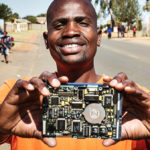 This blog post was guest-written by Annie O’Rourke, CEO of Digital Workforce Australia and 89 Degrees East. She will be guest speaking about ‘Addressing real world problems with Artificial Intelligence’ session of the Women Rock-IT series on 17 October. To sign up for this or other webinars in the series, click here.
This blog post was guest-written by Annie O’Rourke, CEO of Digital Workforce Australia and 89 Degrees East. She will be guest speaking about ‘Addressing real world problems with Artificial Intelligence’ session of the Women Rock-IT series on 17 October. To sign up for this or other webinars in the series, click here.
By Annie O’Rourke
Don’t tell my husband, but I’ve recently started an affair. No need to be too shocked though, because I’m pretty sure I can package it as so-called ethical polygamy. You see, the object of my new love is Artificial Intelligence (AI). AI has the potential to support people to live better lives – to provide support for people with disability and older Australians. To help teachers provide tailored support to children in classrooms, and support doctors and nurses deliver better patient care. To reduce waste, improve our agricultural techniques, reduce the number of car accidents and criminal activities and so much more. But we don’t hear enough in the mainstream media about the benefits of AI and we certainly don’t hear enough about how we are actually in control of how AI can and should augment our lives.

The discourse about AI is too often focused on the negatives: for example, we see projections of job losses not the job market gains that AI is already delivering. We hear stories of inappropriate data collection and noisy drones while the story of how AI -driven data analysis reduces waiting times in our hospitals goes untold. Did you know Australians are already getting essential medicines delivered directly to their doorstep via these amazing machines? There are of course real issues that need to be worked through, including legislative and regulatory changes, but there is a great deal to be positive and excited about as well.
The fear of losing our privacy, our safety and our even our livelihoods has driven a deep suspicion of AI and technology in our increasingly digital world, and I worry that this fear is preventing us from taking full advantage of what this technology has to offer and is preventing us defining what how we want AI to work for us.
When used for good, AI can transform our lives for the better. It is already transforming the education, health care, finance, manufacturing, transport, energy and legal sectors, and its possible future applications are exponential.
Some years ago, I was involved in the development of Nadia – a world-first digital assistant codesigned by people with disability to help them navigate the National Disability Insurance Scheme (NDIS). Nadia’s development was a real ‘a-ha!’ moment for me. I could see and deeply understand the huge difference this technology could deliver. Nadia could literally change people’s lives for the better and change people’s experience of a government program. Unfortunately, the project ran into a lot of headwind and hasn’t been rolled out yet. However, the experience encouraged me to find other channels for exploring how AI can assist members of our community – not just big brands.
A few months ago I co-authored a paper on the Conversational Economy with Dr Andrew Charlton from Alpha Beta. The newly emerging conversational economy allows people to use their voice – and the simplicity of a conversation – to facilitate meaningful business-to-individual personalized interactions. These systems provide a bridge for a wide range of service providers and can turn something like a 20-page form into a much more accessible conversation, saving people valuable time and energy. The data shows that Australians are already comfortable with the experience with almost a ⅓ of Australian adults using smart speaker devices regularly.

So, I started Digital Workforce Australia (DWA) to help governments, organizations and businesses navigate the constantly changing digital landscape and encourage them to use AI as part of the solution to addressing intractable problems. This opportunity is especially relevant for government. Billions of dollars are spent each year on programs to support vulnerable Australians; people experiencing domestic violence, homelessness and mental health challenges, and those who are victims of bush fires, droughts and floods, as well as Australians who need more help and support navigating the health or education system. AI can make a significant difference to addressing these sorts of challenges. It can tailor our efforts and communications activities, and improve our relationships with and understanding of clients, the community and customers.
My aim was to help decision-makers realize that tech isn’t just for nerdy nerds, but for real people and real businesses too. It can deliver real and positive change if we embrace it and encourage whole communities to join the journey of discovery and exploration.
One thing that is very clear is that AI will not reach its full potential to enhance our lives without more women getting involved in the AI field. Most women I know are not only great communicators and the best multi-taskers in the world, they are also brilliant problem solvers, both in the workplace and in domestic spheres. AI solutions shouldn’t just be associated with coding, algorithms and data sets (although sure, they are important) but be designed and deployed by people who want to change the world for the better. And as we can see from the multitude of incredibly talented young women leading campaigns around the globe – think Greta Thunberg, Malala Yousafzai and Emma Gonzalez – we have plenty of talent to draw from.
Here in Australia, my other company 89 Degrees East has been working with the Council of Small Business Organisations of Australia (COSBOA) to develop an exciting new program to encourage more girls to become entrepreneurs and study science, technology, engineering and math (STEM). To be launched later this year, the initiative is just one way we can support young women to take the plunge into the tech industry. Australia needs more enterprising young women with the skills to thrive in the future workforce and drive economic growth. But girls can’t be what they can’t see – and sadly at the moment the AI and tech worlds are not places where young girls can see themselves.
Through our codesign processes with hundreds of girls across Australia we found that almost a quarter of girls don’t know what an entrepreneur is. Forty percent could not name a female business person, and those who could most frequently cited Hollywood reality star Kylie Jenner[1]
The need for more Australian girls to see enterprise and STEM as a career pathway needs cooperation and commitment from government, businesses, technology companies, entrepreneurs and educators to help those reach ‘ordinary’ Australian girls – and their parents, teachers and future employers – and inspire them to see STEM and enterprise as an exciting career pathway.
By teaching young women these vital skills we can ensure they see the tech world as something they are welcome in and can make a contribution to. That’s why I’m excited to partner with Cisco on the Women Rock IT series and excited to speak on October 17th on a panel on Women Using Artificial Intelligence to solve real-world problems. Through the Enterprising Girl program, we hope to ensure young Australian women are able to see a brighter future for themselves.
And hopefully one day we will have a whole generation of women falling in love with AI as much as I have.
To find out more about the Future Female Entrepreneurs Program go to: www.futurefemaleentrepreneursprogram.com.au.


CONNECT WITH US